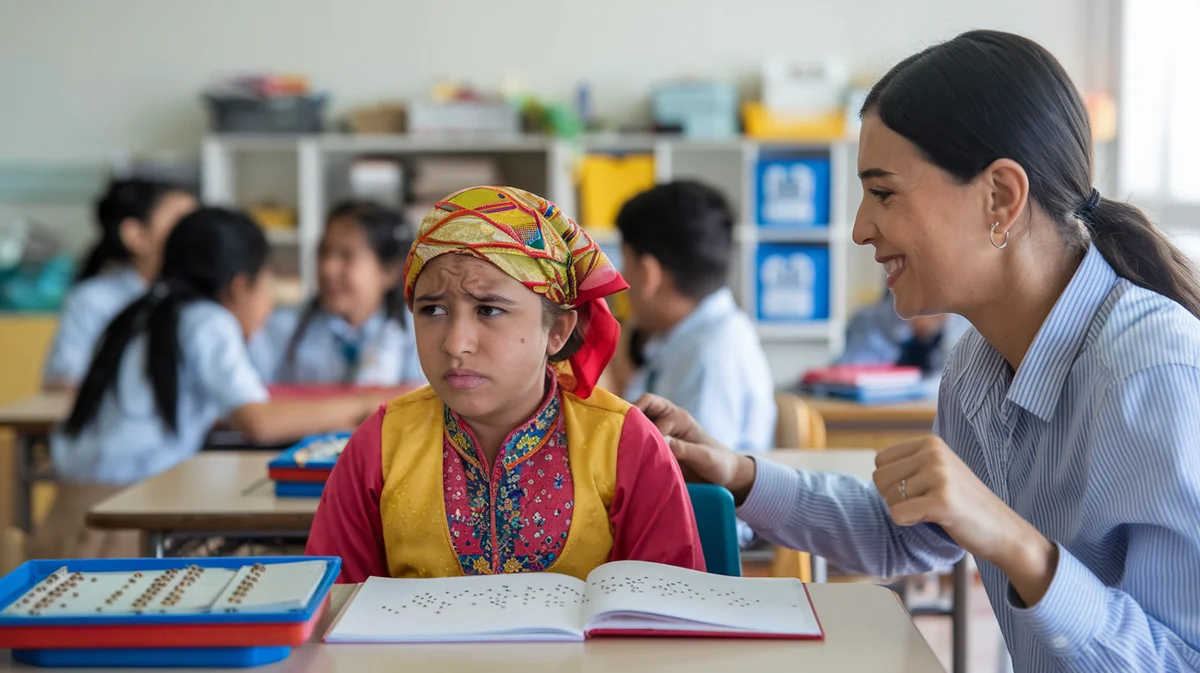Bullying in Inclusive Classrooms: Challenges & Solutions


wp:paragraph
Bullying in inclusive education settings is a pressing issue worldwide, impacting the well-being and academic success of millions of students. At UNOWA, we are committed to empowering institutions, educators, and students to create safe, inclusive, and future-ready learning environments. This article explores the complexities of inclusive education bullying, shares global insights, and highlights proven strategies to foster truly inclusive classrooms.
/wp:paragraph
wp:heading {"level":2}
Understanding Inclusive Education Bullying
/wp:heading
wp:paragraph
Inclusive classrooms are designed to welcome students of all backgrounds and abilities, including those with special educational needs (SEN). However, research shows that these environments can be particularly vulnerable to bullying. According to UNESCO, nearly one in five students globally reports being bullied, with rates even higher in some regions (source).
/wp:paragraph
wp:heading {"level":3}
Key Facts and Statistics
/wp:heading
wp:list
- Global Prevalence: 19.2% of students worldwide report being bullied; in a study of 83 countries, 30.5% of adolescents experienced bullying.
- Regional Variations: The Middle East and North Africa report some of the highest rates, with over 40% of students affected.
- Impact: Bullying leads to anxiety, depression, self-harm, early school leaving, and in severe cases, suicide attempts. Perpetrators are at risk for later psychiatric issues and anti-social behavior.
/wp:list
wp:heading {"level":2}
The European, MENA, and CIS Contexts
/wp:heading
wp:heading {"level":3}
European Union (EU)
/wp:heading
wp:paragraph
In the EU, including countries like Bulgaria, Malta, and Poland, research highlights the critical role of teacher behavior in preventing discriminatory bullying. When teachers treat all students equally, bullying rates drop significantly. Conversely, perceived favoritism — such as preferring native students over immigrants or Roma children — correlates with higher bullying incidents (European Commission report).
/wp:paragraph
wp:heading {"level":3}
MENA Region
/wp:heading
wp:paragraph
Countries such as Saudi Arabia, UAE, and Qatar face some of the highest bullying rates globally. Cultural factors, rapid educational reforms, and varying levels of teacher preparedness contribute to these challenges. National anti-bullying policies are increasingly being adopted, but implementation and teacher training remain key hurdles.
/wp:paragraph
wp:heading {"level":3}
CIS Countries
/wp:heading
wp:paragraph
In Kazakhstan, Uzbekistan, and neighboring states, inclusive education is expanding rapidly. However, stigma around disability and limited resources can exacerbate bullying risks for SEN students. Government initiatives and international partnerships are beginning to address these gaps, emphasizing teacher training and community engagement.
/wp:paragraph
wp:heading {"level":2}
Why Are Inclusive Classrooms Vulnerable?
/wp:heading
wp:paragraph
Inclusive classrooms bring together students with diverse needs, backgrounds, and abilities. While this diversity enriches learning, it can also expose differences that become targets for bullying. Students with disabilities or from minority groups are particularly at risk.
/wp:paragraph
wp:heading {"level":3}
Common Risk Factors
/wp:heading
wp:list
- Perceived Differences: Students who are “different” in any way — be it ability, ethnicity, or language — are more likely to be bullied.
- Teacher Attitudes: Unconscious bias or lack of training can lead to unequal treatment.
- School Climate: Inconsistent rules, lack of student participation, and unclear reporting mechanisms can foster environments where bullying thrives.
/wp:list
wp:heading {"level":2}
Proven Strategies for Preventing Bullying in Inclusive Education
/wp:heading
wp:paragraph
At UNOWA, we believe that empowering educators and institutions with the right tools and knowledge is the key to transforming learning experiences. Here are some evidence-based strategies:
/wp:paragraph
wp:heading {"level":3}
1. Whole-School Approach
/wp:heading
wp:paragraph
A comprehensive, whole-school strategy is essential. This includes clear anti-bullying policies, regular staff training, and active involvement of students and parents. UNESCO and the European Agency for Special Needs and Inclusive Education both advocate for this approach (UNESCO guidelines).
/wp:paragraph
wp:heading {"level":3}
2. Teacher Training and Professional Development
/wp:heading
wp:paragraph
Teachers are on the front lines of preventing and addressing bullying. Training programs should focus on:
/wp:paragraph
wp:list
- Recognizing signs of bullying, especially subtle or discriminatory forms.
- Implementing restorative practices rather than punitive measures.
- Fostering empathy and respect for diversity.
/wp:list
wp:paragraph
At UNOWA, our training modules are designed to build these competencies, ensuring teachers are confident and prepared.
/wp:paragraph
wp:heading {"level":3}
3. Student Participation and Empowerment
/wp:heading
wp:paragraph
Research shows that when students help shape school rules and policies, bullying rates decrease. Encouraging student voice and leadership — such as peer mediation programs — builds a sense of ownership and community.
/wp:paragraph
wp:heading {"level":3}
4. Safe Reporting Mechanisms
/wp:heading
wp:paragraph
Students must feel safe to report bullying without fear of retaliation. Anonymous reporting tools, clear procedures, and visible support from school leadership are critical.
/wp:paragraph
wp:heading {"level":3}
5. Inclusive Curriculum and Materials
/wp:heading
wp:paragraph
Curriculum should celebrate diversity and promote understanding of different abilities, cultures, and backgrounds. Our MIKKO platform provides adaptable, curriculum-aligned content that supports inclusive education goals.
/wp:paragraph
wp:heading {"level":2}
The Role of Educational Technology
/wp:heading
wp:paragraph
Modern educational technology can be a powerful ally in combating bullying. Digital platforms enable:
/wp:paragraph
wp:list
- Real-time reporting and analytics: Schools can track incidents and identify patterns.
- Accessible learning materials: Ensuring all students, including those with SEN, have equal access.
- Virtual training: Scalable, on-demand professional development for educators.
/wp:list
wp:paragraph
UNOWA’s Ulabs and analytics solutions are designed to help schools monitor, prevent, and respond to bullying effectively.
/wp:paragraph
wp:heading {"level":2}
Policy, Regulation, and International Guidelines
/wp:heading
wp:heading {"level":3}
European Union
/wp:heading
wp:paragraph
The EU’s “Council Recommendation on promoting common values, inclusive education, and the European dimension of teaching” urges member states to prioritize anti-bullying measures and teacher training (EU policy)).
/wp:paragraph
wp:heading {"level":3}
MENA and CIS
/wp:heading
wp:paragraph
Many countries are aligning with UNESCO’s “School Violence and Bullying: Global Status Report” recommendations, focusing on national policies, teacher training, and community involvement.
/wp:paragraph
wp:heading {"level":3}
Recent Developments
/wp:heading
wp:list
- UNESCO’s 2023 Global Education Monitoring Report highlights the need for data-driven, context-sensitive approaches to bullying in inclusive settings.
- Several CIS and MENA countries have launched new national anti-bullying campaigns, emphasizing inclusive education.
/wp:list
wp:heading {"level":2}
Expert Insights
/wp:heading
wp:quote
“Inclusive education is not just about physical access to classrooms; it’s about creating a culture where every student feels safe, valued, and empowered to learn.” — Dr. Anna Petrova, Inclusive Education Specialist
/wp:quote
wp:quote
“Teacher training is the single most effective tool in reducing bullying in inclusive classrooms.” — European Agency for Special Needs and Inclusive Education
/wp:quote
wp:heading {"level":2}
UNOWA’s Commitment
/wp:heading
wp:paragraph
With over 15 years of experience and more than 300 national projects delivered, we are dedicated to supporting ministries, schools, and educators in building inclusive, safe learning environments. Our solutions are adaptable to national standards and designed for large-scale impact.
/wp:paragraph
wp:paragraph
Learn more about our approach and solutions at UNOWA.
/wp:paragraph
wp:heading {"level":2}
Frequently Asked Questions (FAQ)
/wp:heading
wp:heading {"level":3}
What is inclusive education bullying?
/wp:heading
wp:paragraph
Inclusive education bullying refers to any form of bullying that occurs in classrooms designed to include students of all abilities and backgrounds, particularly targeting those with special educational needs or from minority groups.
/wp:paragraph
wp:heading {"level":3}
How can schools prevent bullying in inclusive classrooms?
/wp:heading
wp:paragraph
Schools can prevent bullying by adopting a whole-school approach, providing teacher training, fostering student participation, implementing safe reporting mechanisms, and using inclusive curriculum materials.
/wp:paragraph
wp:heading {"level":3}
What role does technology play in preventing bullying?
/wp:heading
wp:paragraph
Educational technology enables real-time reporting, data analysis, accessible learning materials, and scalable teacher training — all of which are crucial in preventing and addressing bullying.
/wp:paragraph
wp:heading {"level":3}
Are there international guidelines for addressing bullying in inclusive education?
/wp:heading
wp:paragraph
Yes. UNESCO, the European Union, and various national ministries provide guidelines and policies focused on anti-bullying measures, teacher training, and inclusive school environments.
/wp:paragraph
wp:heading {"level":3}
How does UNOWA support schools in tackling bullying?
/wp:heading
wp:paragraph
We offer comprehensive educational systems, including inclusive education platforms, STEM innovation, curriculum-aligned content, teacher training, and analytics — all designed to empower schools to create safe, inclusive learning environments.
/wp:paragraph
wp:heading {"level":2}
Further Reading
/wp:heading
wp:list
- UNESCO: School Violence and Bullying
- European Agency for Special Needs and Inclusive Education
- UNICEF: Ending Violence in Schools
- UNOWA
/wp:list
wp:paragraph
Let’s work together to transform learning experiences for the better — empowering every student to thrive in a safe, inclusive classroom.
/wp:paragraph








